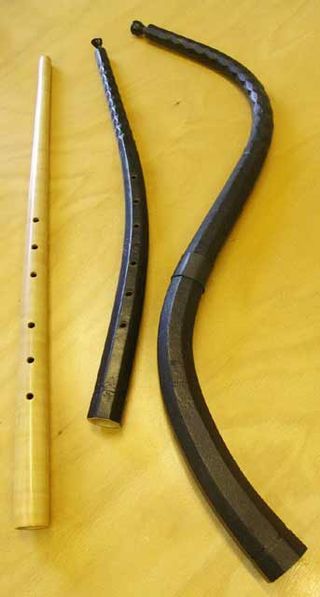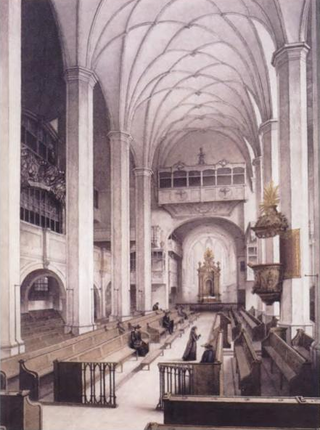
The cornet is a brass instrument similar to the trumpet but distinguished from it by its conical bore, more compact shape, and mellower tone quality. The most common cornet is a transposing instrument in B♭. There is also a soprano cornet in E♭ and cornets in A and C. All are unrelated to the Renaissance and early Baroque cornett.

The French horn is a brass instrument made of tubing wrapped into a coil with a flared bell. The double horn in F/B♭ is the horn most often used by players in professional orchestras and bands, although the descant and triple horn have become increasingly popular. A musician who plays a horn is known as a horn player or hornist.

A sackbut is an early form of the trombone used during the Renaissance and Baroque eras. A sackbut has the characteristic telescopic slide of a trombone, used to vary the length of the tube to change pitch, but is distinct from later trombones by its smaller, more cylindrically-proportioned bore, and its less-flared bell. Unlike the earlier slide trumpet from which it evolved, the sackbut possesses a U-shaped slide with two parallel sliding tubes, rather than just one.

The cornett (Italian: cornetto, German: Zink) is a lip-reed wind instrument that dates from the Medieval, Renaissance and Baroque periods, popular from 1500 to 1650. Although smaller and larger sizes were made in both straight and curved forms, surviving cornetts are mostly curved, built in the treble size from 51 to 63 cm (20 to 25 in) in length, usually described as in G. The note sounded with all finger-holes covered is A3, which can be lowered a further whole tone to G by slackening the embouchure. The name cornett comes from the Italian cornetto, meaning "small horn".

A transposing instrument is a musical instrument for which music notation is not written at concert pitch. For example, playing a written middle C on a transposing instrument produces a pitch other than middle C; that sounding pitch identifies the interval of transposition when describing the instrument. Playing a written C on clarinet or soprano saxophone produces a concert B♭, so these are referred to as B♭ instruments. Providing transposed music for these instruments is a convention of musical notation. The instruments do not transpose the music; rather, their music is written at a transposed pitch. Where chords are indicated for improvisation they are also written in the appropriate transposed form.
The Western concert flute is a family of transverse (side-blown) woodwind instruments made of metal or wood. It is the most common variant of the flute. A musician who plays the flute is called a “flautist” in British English, and a “flutist” in American English.

Hille Perl is a German virtuoso performer of the viola da gamba and lirone.

The tenor cornett or lizard was a common musical instrument in the Renaissance and Baroque periods. This instrument was normally built in C and the pedal (lowest) note of the majority of tenor cornetts was the C below middle C. A number of surviving instruments feature a key to secure the lowest note. The instrument has a useful range of approximately two and a half octaves, however, an experienced player with a strong embouchure may be able to push the instrument higher.
The Missa Salisburgensis à 53 voci is perhaps the largest-scale piece of extant sacred Baroque music, an archetypal work of the Colossal Baroque that is now universally accepted to be by Heinrich Ignaz Franz Biber. The manuscript score of this Mass was rediscovered in the 1870s in the home of a greengrocer in Salzburg, Austria. It has been said to have narrowly escaped being used to wrap vegetables. In the late 19th century, musicologists, notably August Wilhelm Ambros and Franz Xavier Jelinek, attributed it to Orazio Benevoli, and argued that it had been performed in 1628; however in the mid-1970s, through modern methods of analyzing handwriting, watermarks, and history, Ernst Hintermaier "proved...definitely" that it was not by Benevoli. He also demonstrated that it must have been written for the 1682 commemoration of the 1100th anniversary of the Archbishopric of Salzburg. Hintermaier wrote in 2015 that the evidence rules out both Benevoli and Andreas Hofer, Biber's colleague, and concludes that "... the only possible composer of the Mass and the [companion] motet [for 54 voices, Plaudite Tympana] was Heinrich Ignaz Franz Biber... both the sources and the stylistic analysis clearly point to Biber as the author of the works."

Johann Sebastian Bach composed the church cantata Es ist nichts Gesundes an meinem Leibe, BWV 25 in Leipzig for the 14th Sunday after Trinity and first performed it on 29 August 1723.
The 17th century organ composers of Germany can be divided into two primary schools: the north German school and the south German school. The stylistic differences were dictated not only by teacher-pupil traditions and international influences, but also by separate organ building traditions: northern organs tend to have a tower layout with emphasis on the pedal division, while southern and Austrian instruments are typically divided around a window and emphasize manual divisions.

Sebastian Knüpfer was a German composer, conductor and educator. He was the Thomaskantor, cantor of the Thomanerchor in Leipzig and director of the towns's church music, from 1657 to 1676.

The mute cornett was an important variant of the treble cornett and it was used in compositions by European composers in the 16th, 17th and 18th centuries. A significant number of mute cornetts have survived and are preserved in various European museums. Modern makers of cornetts produce mute cornetts and the numbers of recordings of music featuring this instrument has increased in recent years.

The Ricercar Consort is a Belgian instrumental ensemble founded in 1980 together with the Ricercar record label of Jérôme Lejeune.
The sopranino recorder is the second smallest recorder of the modern recorder family, and was the smallest before the 17th century.
A Christmas cantata or Nativity cantata is a cantata, music for voice or voices in several movements, for Christmas. The importance of the feast inspired many composers to write cantatas for the occasion, some designed to be performed in church services, others for concert or secular celebration. The Christmas story, telling of music of the angels and suggesting music of the shepherds and cradle song, invited musical treatment. The term is called Weihnachtskantate in German, and Cantate de Noël in French. Christmas cantatas have been written on texts in several other languages, such as Czech, Italian, Romanian, and Spanish.
Musical instruments used in Baroque music were partly used already before, partly are still in use today, but with no technology. The movement to perform music in a historically informed way, trying to recreate the sound of the period, led to the use of historic instruments of the period and to the reconstruction of instruments.

A horn is any of a family of musical instruments made of a tube, usually made of metal and often curved in various ways, with one narrow end into which the musician blows, and a wide end from which sound emerges. In horns, unlike some other brass instruments such as the trumpet, the bore gradually increases in width through most of its length—that is to say, it is conical rather than cylindrical. In jazz and popular-music contexts, the word may be used loosely to refer to any wind instrument, and a section of brass or woodwind instruments, or a mixture of the two, is called a horn section in these contexts.
Miriam Feuersinger is an Austrian soprano.

The soprano trombone is the soprano instrument in the trombone family of brass instruments, pitched in B♭ an octave above the tenor trombone. As the bore, bell and mouthpiece are similar to the B♭ trumpet, it tends to be played by trumpet players rather than trombonists. Compared to tenor, bass, or even uncommon alto, the soprano is a rare trombone. Seldom used in classical music since its first known appearance in 1677, it survived principally in the trombone ensembles of Moravian Church music. During the 20th century some soprano trombones—dubbed slide cornets—were made as novelties or for use by jazz trumpet players including Louis Armstrong and Dizzy Gillespie. A small number of contemporary proponents of the instrument include jazz artists Wycliffe Gordon and Christian Scott, and classical trumpeter Torbjörn Hultmark, who advocates for its use as an instrument for young children to learn the trombone.













